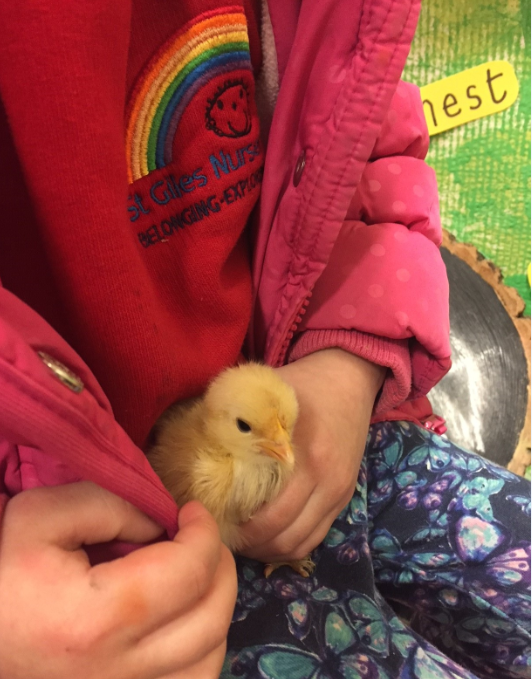School Animals

Interacting with and learning about live animals allows children the opportunity to learn in a much deeper and richer way. It also teaches children about care, responsibility and sometimes, sadly, life and death. Considering the needs of another is one of the building blocks of empathy and learning to talk about feelings and emotions is a lifelong wellbeing skill. We have books in nursery about the pets or visiting animals, the country they come from and habitat, this allows for much talking and learning.
Our children benefit from;
Annual hatching of chicks and caring for them in the Orchard.
Caring for our wild friends- the squirrel and birds in the Orchard.
Watching frogspawn and then tadpoles turning into froglets
Welcoming visits from Pets at Home friendly staff and animals
Hatching eggs into caterpillar and metamorphosing into butterflies.
Welcoming visting animals: Stick insects, giant African land snails, chameleons, dogs.
A visit from some Shire Horses!
Going to Whisby and the Beehive farm for lambing and the Lincolnshire Show!
Animals in the setting as pets
- We take account of the views of parents and children when selecting an animal or creature to keep as a pet in the setting.
- We carry out a risk assessment with a knowledgeable person accounting for any hygiene, allergies or safety risks posed by the animal or creature.
- We provide suitable housing for the animal or creature and ensure it is cleaned out regularly and kept safely.
- We ensure the correct food is offer at the right times.
- We make arrangements for weekend and holiday care for the animal or creature.
- Children are taught correct handling and care of the animal or creature and are always supervised.
- Children wash their hands after handling the animal or creature and do not have contact with animal soil or soiled bedding.
- Staffs wear disposable gloves when cleaning housing or handling soiled bedding.
- If animals or creatures are brought in by visitors or other parents they are the responsibility of the owner.
- The owner carries out a risk assessment, detailing how the animal or creature is to be handled and how any safety or hygiene issues will be addressed.
Visits to farms
- Before a visit to a farm a risk assessment is carried out by a staff member – this may take account of safety factors listed in the farm’s own risk assessment which should be viewed.
- The outings procedure is followed.
- Children wash their hands after contact with animals.
- Outdoor footwear worn to the farms are cleaned of mud and debris and should not be worn indoors.
Legal Framework
The Management of Health and Safety at Work Regulations 1999
Animal welfare :2010 to 2015 government policy: https://www.gov.uk/government/publications/2010-to-2015-government-policy-animal-welfare/2010-to-2015-government-policy-animal-welfare
Further Guidance
Health and Safety Regulations (2003)

